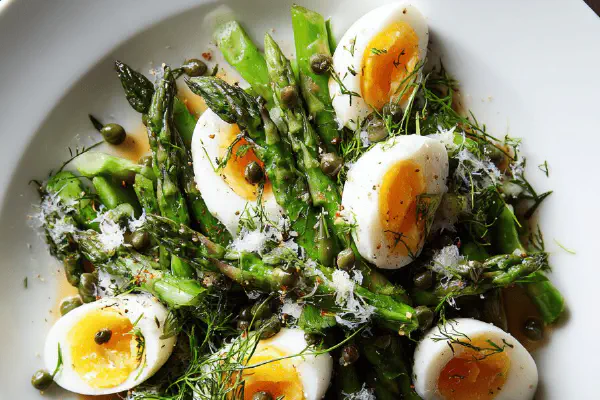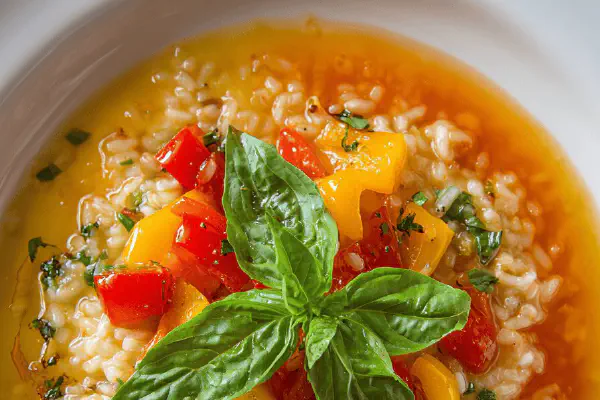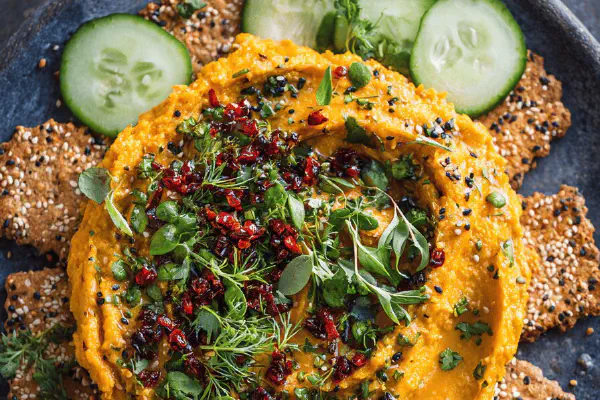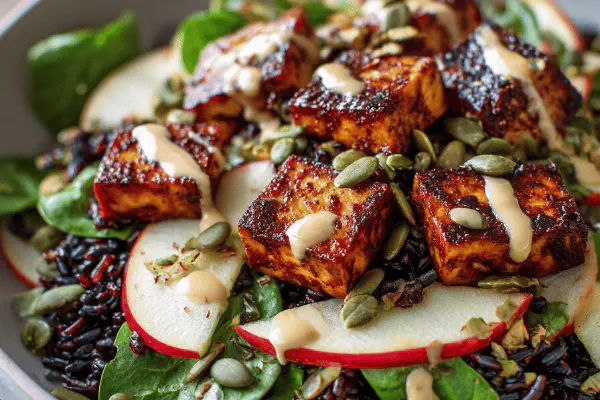Asparagus Mimosa Remix

By Emma
Certified Culinary Professional
Ingredients
- 500 g fresh asparagus, trimmed medium thick
- 1 soft-boiled egg
- 15 ml champagne vinegar
- 5 ml Dijon mustard
- 45 ml garlic-infused olive oil
- 15 ml chopped pickled capers
- Salt and freshly cracked black pepper
About the ingredients
Method
- Bring salted water to boil. Drop asparagus in. Watch carefully. Slightly softer than usual, 4 minutes max. Perfect al dente—still snap and color vibrate. Drain immediately. Pat dry extensively to stop carryover cooking. Let cool till just warm, not cold or hot.
- Cut soft-boiled egg in half. Separate white and yolk carefully. Using fine side of box grater, grate egg white first; tiny feathery strands keep light texture, like fresh snow. Then grate yolk separately—the richer, crumbly bits want their own spotlight.
- In small bowl, combine champagne vinegar and Dijon mustard. Whisk thoroughly. Slowly drizzle in garlic-infused olive oil while stirring vigorously to create emulsified vinaigrette. Add pickled capers last—small pops of salt and tang bite through richness.
- Toss warmed asparagus in about 25 ml vinaigrette, gently but thoroughly. Taste, adjust salt and pepper precisely—champagne vinegar is sharper than expected. Some days needs extra mustard punch; other times just a pinch. Trust nose and tongue.
- Arrange dressed asparagus on shallow dish. Carefully arrange grated egg white along one side, yolk on opposite side. Visual contrast essential—windown to layering flavors. Drizzle remaining vinaigrette over top. Serve warm or room temperature—never icy cold; mutes flavors.
- Eat immediately or within hour—textural shift quick, asparagus soggier over time. Leftovers? Dress asparagus after reheating briefly in steam to revive crunch.
Cooking tips
Chef's notes
- 💡 Blanch asparagus just right; time crushes texture. Four minutes max for medium-thick stalks is a guideline, not gospel. Watch color—bright green then dull signals overcook. Snap soft but present. Drain fast; pat dry or risk watery vinaigrette. Carryover heat dulls crispness; cool till warm only. Timing matters here more than flame height.
- 💡 Soft-boiled egg needs precise timing. Five minutes in boiling water then immediate ice bath locks texture; whites set but tender, yolks crumbly not chalky. Peel gently to avoid mush. Grate whites and yolks separately on fine side and medium side of box grater; preserve airy strands and rustic chunks for contrast. Avoid puree or blending.
- 💡 Make vinaigrette by slowly whisking garlic-infused olive oil into sharp champagne vinegar and Dijon mustard base. Add oil drop by drop at first; emulsification fragile. Mustard grain and freshness influence stability. Salt hesitantly; too early or too much breaks sauce. Finish with pickled capers last to keep bursts of brightness intact; rinse if overly salty.
- 💡 Dress warm asparagus gently. About half vinaigrette to start, toss lightly but thoroughly. Taste and tweak seasoning as champagne vinegar punches sharp; balance with mustard or oil if needed. Warm not hot; too hot softens asparagus too fast, muting texture. Keep some dressing for drizzling on plate; preserves layered flavor and visual appeal.
- 💡 Serve immediately or within an hour; textures shift fast. Leftover asparagus sogginess from moisture release is a real problem. Reheat quickly with steam just to revive snap before adding more vinaigrette again. Grated eggs lose charm when sitting; don’t mix yolks and whites or risk dull flatness visually and texturally.
Common questions
How long to blanch asparagus exactly?
Depends on thickness, four minutes usual. Watch color change, look for bright green then slight dull. Snap test critical. Overcook means limp mush. Immediately drain or cooking never stops; pat dry fast to keep crunch.
Why separate egg white and yolk?
Texture contrast main reason. White grates into feathery fines, yolk richer crumbly bits. Mixed, loses interest. Separate grating preserves rustic look and feel. Also avoids homogenized flavors; better taste dimension.
Can I substitute vinegar?
Champagne vinegar sharper than usual. White wine or sherry vinegar possible but change punch. Reduce mustard if vinegar milder. Some add touch sugar to balance sharpness. Avoid balsamic here; too dark, sweet, overwhelms light asparagus.
Best way to store leftovers?
Refrigerate covered; asparagus sogginess happens quick. Reheat briefly steaming, not microwaving, or cold lose texture. Store vinaigrette separately if possible. Reassemble just before eating to protect crispness and egg texture.



